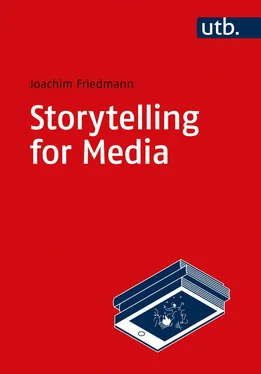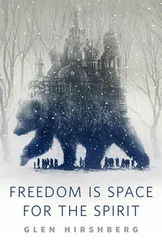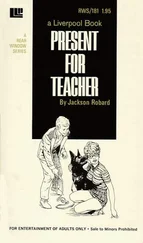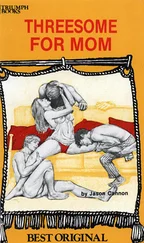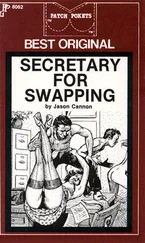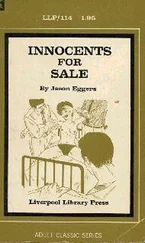|
EXERCISE: |
|
Find and name the archetypes in one of your favorite movies. |
|
|
|
Try to describe the thematic, functional, and psychological dimensions of one of your favorite narrative characters. |
3 Setting – The Narrative Space
A story is spatially located – this statement is almost commonplace in narratology. It means that the actions and events of a narrative take place in one or more places – what is referred to as the setting in a dramaturgical terminology. But is the design of a narrative space subject to a narrative specificity or is it a purely descriptive representation because a story presupposes the space in which it takes place? In this case, a route description or driver directions would also fulfil all the criteria for defining a story. The driver, as a protagonist, is following directions, following a map, where they cross a given space and finally arrive at their destination. It’s likely that they must also overcome obstacles on the way that trigger conflicts, e.g. in the form of construction sites or traffic restrictions. A travelogue in a book or newspaper article could also be considered a narrative. Intuitively, however, such a text would not necessarily be defined as a story.
In this respect, one has to ask whether there are special strategies of narrative spatial design. As was already clear from the description of the narrative figure, the representation of a character of a story is subject to different design principles than in a purely descriptive text. This also applies to narratively depicted spaces.
For a long time, narrative spatial design was hardly an issue for structuralist narratology. One reason for this was probably to be found in the roots of narratology in linguistics and literary studies and the associated focus on literary narratives, thus, in turn, there is a focus on questions of temporality, narrator position, and narrative perspective. In fact, in contrast to visual narrative media such as film, comics or games, verbally conveyed narratives can even completely dispense with description of places. In jokes, for example, as a short form of narrative, often a dialogue takes place without a locality being depicted. Even if this may be a theoretical option in literature, narratologist GERARD GENETTE refers to the possibility of telling a story without location, while it would not be possible to situate it without temporal reference in the present, past, or future. Genette concludes that the temporal determinations of narration are more important than the spatial ones.
3.1 Juri Lotman and Semantic Space
The semiotician JURI LOTMAN, on the other hand, points out for the first time that it is precisely the design of space that is of decisive importance in the production of meaning.
“The most general social, religious, political, and ethical models of the world, with whose help man comprehends the world around him at various stages in his spiritual development, are invariably invested with spatial characteristics […] This property of spatial models is extremely important for art.” (318)
Lotman does not define more precisely what he understands as an artistic text, but since he develops his model paradigmatically through narrative texts, it can be assumed that he links his considerations to the narrative form. He calls the narrative text a “plot,” whereby for him this plot consists of three necessary elements:
1 “some semantic field divided into two mutually complementary subsets;
2 the border between these subsets, which under normal circumstances is impenetrable, though in a given instance (a text with a plot always deals with a given instance) it proves to be penetrable for the hero-agent;
3 the hero-agent.” (240)
Put simply, Lotman formulates a minimal definition of a narrative. For him, this consists of two spaces separated by a border and a protagonist, whom he calls “hero.” The most important and defining step in the plot is the hero-agent’s crossing of a border.
What is particularly important here is the concept of the “semantic field,” (97) which describes the narrated world. As shown, Lotman assumes that the human cognitive process and thus the production of meaning is primarily spatially organized, i.e., that space is the bearer of meaning, whereby Lotman is in agreement with more recent human geographical and cognitive psychological findings. According to Lotman, this semantization of space takes place in narrative texts on three levels: first, space is characterized by binary topological oppositions such as “above vs. below” or “inside vs. outside.” Second, the topological oppositions are linked to semantic oppositions such as “good vs. evil,” “protected vs. unprotected,” or “artificial vs. natural.” Third, in the narrated world, these oppositions are created by spatial conditions and topographically realized in the text of the narrative, for instance as mountain and valley, house and forest or – as Lotman shows in Dante’s Divine Comedy – heaven and hell.
The space in narratives is thus not a neutral container, but through semantization makes action in this space meaningful in the first place. This is where the second important term of Lotman’s definition comes into play, the border. For Lotman, the most important topological feature of space is the boundary, which divides semantic space into at least two subspaces in opposition, such as urban and rural space, or the profane world of everyday life in opposition to the magical world of adventure. In Lotman’s model, the motif of crossing the border is of particular importance: the border is impermeable and insurmountable for everyone except the hero of the narrative. Crossing the border defines him or her as the protagonist of the story.
Although he does not refer specifically to his works, Lotman is in agreement with the aforementioned anthropologist Joseph Campbell and his concept of the monomyth. Here, too, the moment of crossing borders is a constitutive element, from the world of profane and everyday life to the world of magic and adventure. Christopher Vogler, who has used Campbell’s insights as a structuring model for film dramaturgy, also recognizes the structural border between the 1st and 2nd acts in the hero’s transgression of boundaries. Campbell describes the semanticized spaces and their topological connections. According to Campbell’s observation, the hero is often prevented from crossing the border by a threshold guardian, which can also be depicted by a high wall or a large gate. In mythological narratives, these borders are usually positioned at the upper or lower end of the world – also topological attributions. Thus, the heroine in Mother Holle must first jump into a deep well, needing to reach the very bottom of a deep hole. Having arrived in the magical world, the heroine has to help Mother Holle, who is responsible for snowfall on planet Earth – and so, is carrying out her duties at the very top of the vault of heaven. The hero’s way back into the world of everyday life leads her through a large, magnificent gate where she receives her reward in the form of golden.
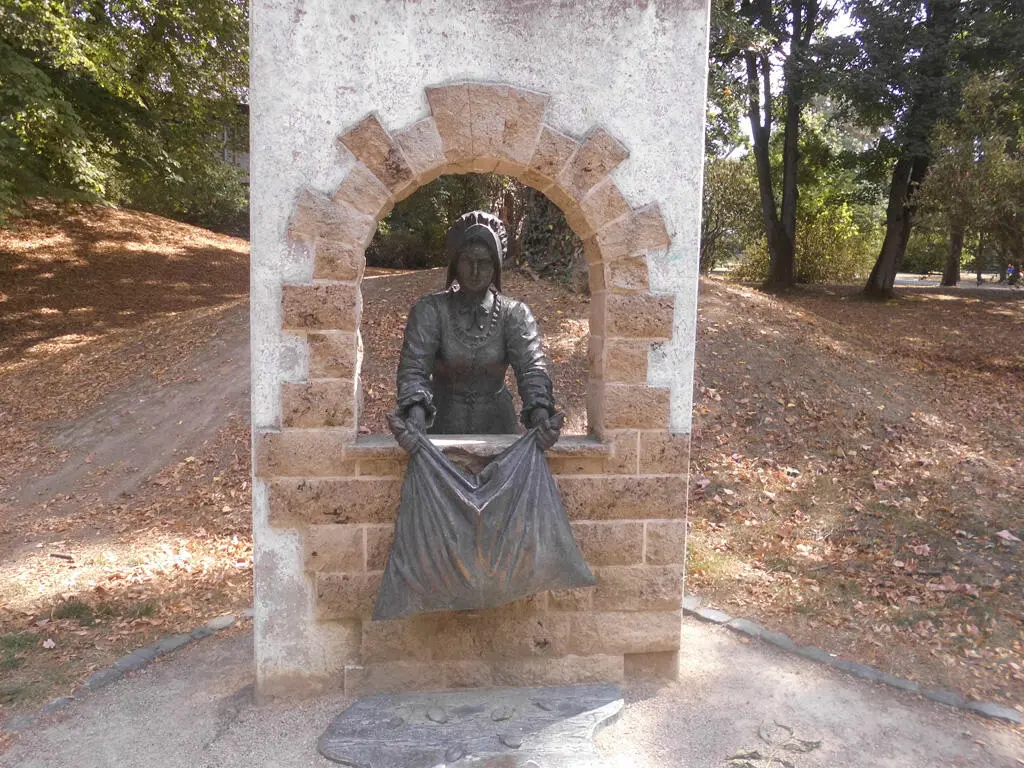
Frau Holle monument in the Frau Holle Park in Hessisch Lichtenau. Photo by Markus Kroll, Creative Commons license.
Lotman’s model can be especially useful when applying it to mythological narratives, not only to the original sagas and myths that Campbell has studied but also to narratives built on similar structural principles. Thus, in Tolkien’s The Lord of the Rings , the hero Frodo has to move from his homeland, the green valley in the Shire, to the elevated, black Mordor, from bottom to top, from fertile land to barren mountains, from idyllic, good homeland to an evil foreign land. Only he and his companion Sam Gamgee cross the border to Mordor, where the giant spider Shelob guards the threshold. It should be noted that the border to Mordor is by no means the only one the heroes have to overcome. Middle Earth, the setting of the novel, is made up of a multitude of semantic spaces with different topographical features: the companions must cross the dangerous and enchanted Old Forest, they must climb the desolate, deserted Weathertop, and they must descend into the dark, underground mining town of Khazad-dûm.
Читать дальше
